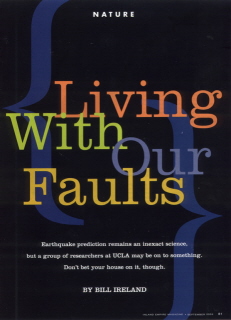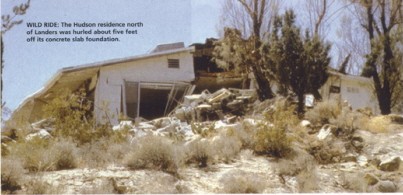FEATURE ARTICLES
Living With Our Faults
Published in Inland Empire Magazine—September 2004
The risk of earthquakes has always been a backdrop to life in California. Most long-time residents have a mental file of earthquake experiences, ranging from droll to dramatic.

For drama, it’s hard to beat the 1994 Northridge Quake. At 4:30 a.m. on January 17, residents were jolted awake by a magnitude-6.9 shaker that flattened freeways and buildings across the Los Angeles basin. It was the first large temblor to occur directly under a U.S. city since the 1933 Long Beach Quake. As such, it was a kind of test case for southern California: what happens when major seismic activity coincides with heavily-populated areas?
The answer was sobering. Because it happened early in the morning, loss of life was limited. But property damage reached $30 billion, and the ensuing chaos provoked a financial crisis whose reverberations are still being felt.
As terrible as the Northridge Quake was, it was mild compared to the mega-quake that hits somewhere in the world every year. Fortunately, most of these events occur in uninhabited areas. As new home developments spring up around the San Andreas Fault, the question persists: what would a truly catastrophic earthquake do to California’s suburban environment?
A hint came two years earlier, in the 1992 Landers Quake. Less noticed than the Northridge event, Landers registered a magnitude 7.3. It opened a surface rupture 53 miles long, and created fault slippage up to 18 feet. And it was uncomfortably close to the granddaddy of all earthquake faults—the San Andreas. But because of its remote desert location, few people experienced it. It was the strongest quake to strike southern California in 35 years.
Since then, an unprecedented real estate boom has pushed development further into the desert. Palmdale, Yucaipa, and Banning all have two things in common: they’re experiencing record population growth—and they’re on the San Andreas Fault System. This lends more urgency to the perennial question: when will the next big one hit?

One scientist has made headlines with his answer. Dr. Vladimir Keilis-Borok is Professor-in-residence at the Institute of Geophysics and Planetary Physics. (If the group’s name sounds redundant, it’s less daunting than this statement of purpose: “The study of self-organization in Earth’s fault systems and of spatio-temporal complexity in plate tectonics, mantle convection, solar and planetary dynamo action, Solar System formation, and the structure of interplanetary magnetic fields…”) The institute is based at the University of California, Los Angeles, but Keilis-Borok’s career began in Moscow, where he earned a PhD in mathematical geophysics in 1948. There, he founded the International Institute of Earthquake Prediction Theory and Mathematical Geophysics. His team at UCLA brings together experts in various disciplines, including seismology, geodynamics, pattern recognition, chaos theory, statistical physics and public safety.
At the beginning of 2004, the team made a prediction: a magnitude-6.4 quake or larger would hit a specific region of southern California between January 5, 2004 and September 5, 2004. They identified a 12,440 square-mile target area which includes the Coachella Valley, Imperial Valley, the eastern Mojave and eastern Orange County.
Along with headlines, the prediction has drawn controversy. Critics hurled words like “bogus” and “crackpot.” There was concern about how the public might react. In February, the Governor’s Office of Emergency Services called a meeting of the California Earthquake Prediction Evaluation Council.
But the scientific community has responded with guarded respect. The United States Geological Survey called the new theory “a legitimate approach to earthquake prediction research.” Keilis-Borok himself is careful to refer to his project as a “test”—not a prediction.
That attitude is shared by Dr. Lucy Jones, Scientist-in-charge for Southern California at the USGS Earthquake Hazards Team. “He’s in the middle of a test,” she affirms. “He’s not claiming success.” Regarding the specificity of his pronouncement, Jones laughs, “Actually, he’s being very vague.” The area involved, she points out, includes a rather huge swath of territory.
Keilis-Borok’s team looks for “quickly-formed long chains” of small earthquakes, or swarms, that occur in a specific area. Then they examine past data for precursor events in the same locale. If their criteria for a likely future event are met, they issue a nine-month alarm. “It’s a reasonable hypothesis,” says Jones. “The only test is whether or not it works.”
So far, it has. In June 2003, the team predicted an earthquake of magnitude 6.4 or larger would hit central California within nine months. The 310-mile area included San Simeon—where a magnitude 6.5 quake occurred on Dec. 22.
A prediction in July 2003 was for a magnitude-7 or higher temblor to strike Japan by Dec. 28, 2003. The quake hit off Hokkaido Island on Sept. 25, 2003—a magnitude 8.1.

Earlier results were impressive, if not as spectacular. Then, the team was making predictions in years, not months. After the 1992 Landers Quake, they opened an 18-month prediction window for a magnitude-6.6 or higher quake within 120 miles of Landers. They missed it by 21 days—the Northridge Quake hit on January 17, 1994. And, a five year prediction, issued in 1986, was fulfilled by the deadly Loma Prieta Earthquake of 1989.
Now, the prediction window is nine months, and with their successes in 2003, they’re two for two. But scientists aren’t an easy crowd to impress. “Once we’ve gone through five or six of these, we’ll have something to discuss,” says Jones.
Meanwhile, the clock is ticking and the pressure is on. Keilis-Borok himself describes earthquake prediction as the Holy Grail of earthquake science,
and there are lots of scientists chasing it. After many false leads over the years, fatigue has set in among those seeking a reliable formula. It’s proved such a difficult problem; I don’t know many people who wouldn’t be ecstatic if he’s proven right,
says Jones.
The public’s thirst for immediate assurance fuels its fascination for prediction models. It also frustrates seismologists. “We deal in time units of 10,000 years or more,” says Jones. “It’s difficult for society to deal with problems on that time scale.” Her agency does alert the public to near-term risks—especially when moderate-size quakes occur near major faults. “We’ve issued an advisory in those situations,” she says. And state government has pressured seismologists to issue risk-assessments in 30-year periods—because that’s the duration of most home mortgages. But till now, such relatively-short term projections have had little meaning, according to Jones.
Years of taking the long view have given her a philosophical perspective. “You’re more likely to be murdered in Los Angeles that to die in an earthquake,” she points out. “You’re way, way more likely to die in a car accident.” And, there are more important things than knowing about quakes ahead of time: “Would you rather know you have two hours to get out of the house—or that the house will stand up to the shaking?”
When personal safety is not the issue, money is. Insurers abandoned earthquake coverage after the 1992 Northridge disaster. The state responded by establising the California Earthquake Authority, which assures coverage availability. And traditional companies came back with an innovation: the “mini-policy.”
Still, southlanders worry. Having paid premium prices for their property, they feel vulnerable. “Vulnerability is a curious term when it comes to earthquakes,” says Sergio Siderman, General Counsel for Property I.D. in Los Angeles. His firm dispenses comprehensive information on earthquake faults and other potential risks to prospective homebuyers. “You can be 100 or 200 miles away from an earthquake epicenter, and be more vulnerable than if you were ten miles away.”
What’s often more important than location is the age of the home. “Safety standards have significantly improved over the past 50 years,” says Siderman. Many (older) homes would never have been allowed to be built under current guidelines.
Another factor is what’s underneath the house. “You’d rather not be on liquefiable soil—for example, the Marina District in San Francisco. Do you remember, during the earthquake, where all those buildings looked like they were in quicksand?” Siderman asks. “They were leaning over, and looked like they were being sucked into the earth.” A vivid image. “You’ve got buildings built on sandy soil, and a nearby high water table. What happens during an earthquake—sometimes, not always—is that water will mix with the sandy soil, causing the soil to lose its stability. And as a result, you can have moderate to massive destruction of property.”
Inhabitants of dry inland areas may feel immune from that particular threat. They shouldn’t, according to Siderman: “All counties in California have some liquefiable areas.” Dry lake beds are particularly susceptible. Their surfaces may be parched—with the water table lying just underneath.
As the cliché goes, the Big One is coming—whether this year, as Professor Keilis-Borok contends—or in another ten. Till then, old advice applies: make sure the water heater is strapped, bolt the house to the foundation, stock up on bottled water—and hope that this year the professor is wrong.
Note: Hard-core worriers can view real-time seismogram displays at:
http://earthquake.usgs.gov/regional/sca
# # #